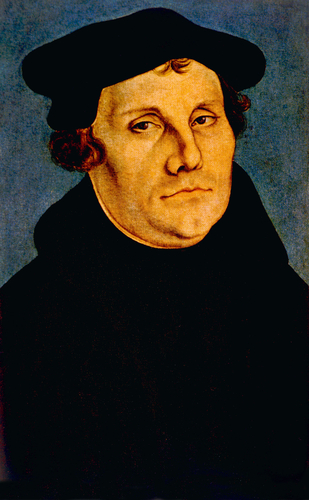It’s a classic story: a hard working blue collar couple wants the best for their son. They pinch pennies and send him to the best schools so that he can become a lawyer instead of following his father’s footsteps down the local ore mine. The young lad starts promising but a rebellious streak awakens and suddenly he’s no longer interested in satisfying his parents wishes.
Not every contrary child goes on to lead the largest church reformation in history but the circumstances are still relatable today. How did Martin Luther go from an anxiety-riddled boy in a small German mining town to religious giant? And who really was Martin Luther? We’ll give you a brief glimpse into one of history’s greatest rebels and the man who started the protestant reformation by standing up to both the pope and the emperor of The Holy Roman Empire.
Childhood Insecurities
Martin Luther was born on November 10, 1483. Two of his younger brothers died from the plague and Martin became obsessed with the notion of salvation. He worried whether his soul would be saved when he died and developed chronic anxiety around the notion.
He complied with his parents’ desire for him to become a lawyer and studied Latin, grammar, logic and other pre-law disciplines of the day. He was well on his way to law school when a thunderstorm changed a 22 year-old Martin Luther forever. Caught walking in the torrential storm, Martin feared he would die. In desperation, he prayed to St Anna, the patron saint of miners, and swore that if he survived he would become a monk.
Scholars argue that Luther was already planning to join the Augustine monastery but the storm seems to have nudged him fully.
Monastic Life
Insecurities about his salvation continued to haunt Martin Luther and he buried himself in the gospels to find relief. It wasn’t until one of his teachers suggested that Martin “focus on Christ alone” that he began to find answers to the gnawing questions that kept him up at night. Luther put more energy into what the Bible said and less into the mechanics of the church.
The real answer came in the book of Romans and in particular the section where Paul writes about “the righteousness of God.” Luther read this as the righteousness of God’s grace. He stopped believing that God was a righteous judge who determined a person’s worth based on their sins and instead saw grace as a gift everyone received equally. This was the beginning of his theory of justification.
Martin Luther’s 95 Theses

Martin rose through the ranks and became a professor of biblical theology at the University of Wittenberg. He became increasingly critical of the church’s practice of selling indulgences – essentially God’s forgiveness – and during a trip to Rome witnessed church corruption first hand. It was then that he reached his breaking point and the true rebel emerged.
Luther’s dissatisfaction led him to post 95 theses, or complaints against the Roman Catholic Church on the door of the university chapel. He also sent a copy to archbishop Albert of Mainz, who didn’t take the critique well. At the same time, the advent of the printing press meant that Martin’s manifesto spread across Germany and Europe. The Protestant movement was born.
Why Did Martin Luther Criticize the Roman Catholic Church?

The fundamental notion of grace is what motivated Martin Luther the most. He wanted to spread his idea that faith equaled salvation. You simply had to believe in Christ’s teachings to be saved. You didn’t need to buy indulgences, you didn’t need to perform certain acts, you didn’t need to behave in a certain way. You simply needed to believe in God’s righteousness.
This idea that the individual controlled their relationship to God along with Luther’s disgust over the church’s corrupt practices and lavish expenses created a rift between him and the Catholic Church. When he was summoned to explain his position, Luther stood behind the scripture. He challenged anyone to show where in the Bible it said he was wrong. The church was speechless and very unhappy. In 1519 Luther received a warning from the pope which he definitely burned in a public display. In 1521 Luther was officially excommunicated from the Catholic Church.
What is the Protestant Reformation?
Luther never stopped teaching. He gained followers and grew the protestant movement which eventually became the Lutheran church. He spent two years in hiding after rebuking emperor Charles V at the Diet of Worms. During his time in exile, he translated the Bible into German so that everyone could read it. In effect, Martin Luther was breaking up the Catholic Church’s monopoly on God and bringing Jesus to the people.
Martin Luther officially left the monastery in 1522. He served as dean of theology at Wittenberg until his death in 1546. Never to be outdone, Martin Luther executed one final gesture of defiance against the church. Via the Protestant movement, he received a plea for help from a group of nuns who were being held prisoner in a convent. Luther hatched a plan along with a fishmonger to sneak the nuns out in barrels. The leader of the nuns, Katharina Bora, eventually became Luther’s wife and they had six children together.
Learn More About Martin Luther
Want to know more about the legendary Martin Luther who defied bishops, emperors and popes to form the Protestant church? Join us at King of Kings Church in Woodbury every week. We believe a nurturing community unites people around the teachings of our founder. If you’d like to discover more about Martin Luther’s teachings and his message of God’s righteousness, please stop by on Sundays. We’d love to meet you!

